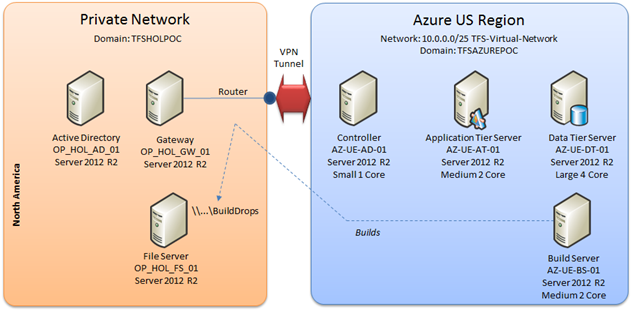Windows Azure – 101 Stuff and a mention of our TFS on Azure IaaS POC
Our TFS on Azure IaaS proof-of-concept (POC), and more recently the merging, editing and reviewing of the practical walkthrough guide, has suggested that some of the Azure stuff deserves some 101 introduction.
Here is a summary view of all the services on our POC:
But what are all various types? Storage Account seems self explanatory, but the others?
1. Cloud Service
A cloud service consists of an application and XML configuration files that define how the cloud service should run. In our POC we note that each virtual machine is contained within a cloud service, which can be managed and monitored as shown:

 Pretty obvious when we completed the POC setup
Pretty obvious when we completed the POC setup ![]()
2. Virtual Machine
Read Willy’s Cave Dwelling Notes #1 – Cloud Computing which I wrote (a while ago) which talks about cloud types. In our case we are using the private cloud implementing virtual machines as an “infrastructure as a service” (IaaS). Selecting the virtual machine (within a cloud service) give you access to tooling, information and more visual feedback:

3. Virtual Network
Probably the most complex and mind-numbing part of our proof-of-concept. The Virtual Network defines a logically isolated section in Windows Azure and allows you to securely connect it to on-premises or a single client machine environments. Before you start your own POC, we encourage you to read our practical walkthrough and learn from the gotchas, unknowns and tweaks as gathered by Chris Margraff during many hours of troubleshooting.
4. Directory
 For the POC we opted not to use the Windows Azure Active Directory for the POC.
For the POC we opted not to use the Windows Azure Active Directory for the POC.
Instead we connected the on-premises active directory to our own instance of active directory running in our Azure POC environment with a one-way trust.
5. Visual Studio Online
VSO has been our production home from day 1! Peruse the following and create your own account today:
- https://www.visualstudio.com/get-started/overview-of-get-started-tasks-vs
- ALM Rangers dogfooding journal of the Team Foundation Service
- How the Visual Studio ALM Rangers use Team Foundation Service to Get Ready for Visual Studio 11
6. Affinity Group
Affinity groups allow us to “group” storage and compute services close to one another keeping them in same data centre and cluster. This reduces potential latency and costs, which we may incur when communicating across data centres.
Next time we will start looking at the actual POC environment and talk about some of our adventures. In the meantime enjoy the cloud, while we consolidate the TFS on Azure IaaS POC walkthrough guide ![]()
 |
This guidance is a companion to the TFS Planning and DR Avoidance Guide and delivers practical and scenario based guidance for the implementation of Team Foundation Server (TFS) on Azure IaaS. We guide you through the planning and decisions, based on real-world proof-of-concept and production deployment experience by the ALM Rangers. … coming soon! |



